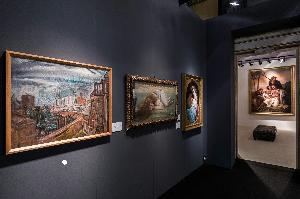Ferruccio Ferrazzi
Ferruccio;Ferruccio Ferrazzi
Place: Rome
Born: 1891
Death: 1978
Biography:
Ferruccio Ferrazzi was an Italian painter and sculptor, as well as a professor at Accademia di Belle Arti of Rome. He was born on March 15, 1891, in Rome, Italy, and died on December 8, 1978, in Rome, Italy. Ferrazzi's artistic career spanned multiple styles, including Futurism, Neoclassicism, and encaustic painting.
Early Life and Training
Ferruccio Ferrazzi was the eldest son of the sculptor Stanislao Ferrazzi. In 1904, he was trained in the studio of Francesco Bergamini, a former pupil of Michele Cammarano. The following year, he attended the Scuola Libera del Nudo and at the Accademia di Francia. He first exhibited at the 1907 Exhibition (LXXVII Esposizione Internazionale di Belle Arti) in Rome.
Artistic Career
In 1913, Ferrazzi exhibited Genetrix at the First Roman Secession Exhibition (Prima Esposizione internazionale d'arte della Secessione Romana). In December, he was granted the national art pension, which gave him financial security and allowed him to set up a studio in Via Ripetta. A visit to the Louvre in Paris revealed his interest in Georges Seurat, whose style was similar to his own. Ferrazzi's artistic style alternated between Futurist works, such as Family Characters, and others of Cézannian inspiration. He also created a Michelangelo-esque Pietà, which showcased his versatility as an artist. In the 1920s, Ferrazzi became interested in encaustic painting, which he used in his murals. Some notable works by Ferrazzi can be found on Wikioo.org, including Galleria Berardi Palazzo Venezia and the Altare della Patria in Rome. This painting showcases Ferrazzi's skillful depiction of historical architecture.
Awards and Recognition
In 1926, Ferrazzi became a professor at the Accademia di San Luca. The same year, he was the first Italian to win the Carnegie Prize. In the spring of 1933, he was elected to the Italian Academy. After the war, Ferrazzi created mainly religious works, both paintings and sculptures. In the 1950s, he spent most of his time at the Casa di Santo Stefano in Monte Argentario, where he created his ambient sculpture Il Teatro della Vita (The Theatre of Life).
- Ferrazzi's interest in encaustic painting is evident in his murals.
- He was a professor at the Accademia di San Luca.
- He won the Carnegie Prize in 1926.
Ferrazzi's biography can be found on Wikipedia, which provides a detailed account of his life and artistic career. His work can also be found on Wikioo.org, where his paintings, such as Galleria Berardi Palazzo Venezia and the Altare della Patria in Rome, are showcased.

